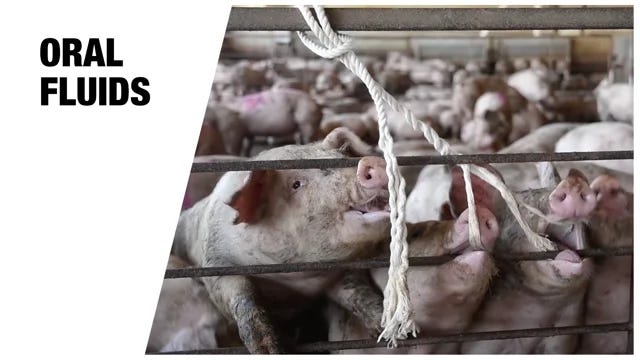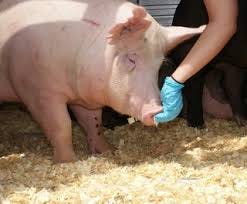H5N1 Confirmation in Oregon Backyard Swine Re-emphasizes Urgent Need for Targeted H5 Swine Surveillance
"Normal" commercial herd diagnostic lab sick pig surveillance may be too late
On Wednesday USDA and Oregon announced detection of H5N1 in back yard swine co-housed with an H5N1-infected poultry flock in Oregon:
USDA later announced that both the poultry flock and the pig were infected with H5N1 clade 2.3.4.4b D1.2, a strain likely to have originated from wild bird contamination and different from the B3.13 genotype currently causing widespread infections in dairy and poultry herds in California, Idaho, Utah, and in other states since early 2024. We can piece together from news accounts that the 5 Oregon pigs “showed no clinical signs”, but that tissue testing showed the infected pig “had virus throughout their body,” according to Dr. Ryan Scholz, Oregon State Veterinarian.
A study by Arruda et al from ARS NADC was published in April 2024 in Emerging Infectious Diseases, which I failed to cover in an earlier blog related to the H5N1 threat in swine. It is definitely worth a read as a fully reviewed publication: Divergent Pathogenesis and Transmission of Highly Pathogenic Avian Influenza A(H5N1) in Swine - Volume 30, Number 4—April 2024 - Emerging Infectious Diseases journal - CDC.
Readers may recall that on October 6th I first blogged regarding the critical stakes involved in dealing with H5N1 2.3.4.4b B3.13 moving into swine: California H5N1 Dairy Outbreak Explodes - Time to Talk Feral and Outdoor Swine Risk. We should soon have some preliminary results from ARS-NADC direct infection and transmission studies with B3.13, added to data reviewed in a 2024 Leman Conference presentation by Dr. Bailey Arruda of ARS NADC regarding swine infection studies with second set of avian and mammalian H5N1 2.3.4.4b strains. This work showed mild clinical signs (including neurologic signs in one case) with systemic viral infection and some onward transmission to contact swine.
More complete ARS NADC results and further results from the Oregon case will soon be available to provide additional guidance in developing more precise swine H5N1 surveillance criteria for producers, their veterinarians, and regulatory personnel. Until then, we really can’t rely typical clinical signs for influenza in pigs to trigger testing for potentially exposed animals; further, we really have no parameters to understand just what constitutes sufficient exposure to justify testing for infection. This makes for very inefficient surveillance guidance; however, I’d argue that the risk for undiagnosed subclinical or asymptomatic H5N1 infections makes “over-swabbing” swine herds prudent in areas with known high H5N1 viral loads (infected poultry and dairy surveillance zones, migratory flyway stops).
Subject matter experts in swine influenza surveillance should be consulted for guidance in effective sampling decisions, with NAHLN variances quickly granted to meet effective influenza sampling alternatives (including oral fluids, and other sampling techniques - see below for 2 examples) for non-clinically ill swine. We cannot hold ourselves prisoners to restrictive and inflexible lab protocols requiring compatible clinical illness and rigid sample types that prevent effective early detection-based sampling implementation!
(unrestrained) Snout Wipe
Dead birds and cats, as well as workers with conjunctivitis signaled an alert to dairy practitioners that “something different” was afoot on dairy farms with H5N1 2.3.4.4b B3.13. Any swine farms with dead birds, cats, rodents, etc., must utilize such signals to immediately test for H5N1 in their pig populations, as well as in the deceased sentinels. Swine herds with any clinical illness in high-risk locations (infected dairy herd or poultry flock surveillance areas), particularly herds showing sudden deaths or neurological signs, should be immediately treated as suspect HPAI FADI’s (foreign animal disease investigations) with formal reporting to Area Veterinarians in Charge and State Animal Health Officials.
It is so important that we find H5 before we move pigs harboring the infection to other sites. Initial H5N1 infected sites may not have coexisting endemic swine influenza infections. However, every time we mix pig populations, we run the risk that a population carrying H5N1 is mixed with a population carrying endemic H1 or H3. As concerning as H5N1 viral mutations (genetic drift) within the new swine hosts may be over time, reassortment of H5N1 with endemic swine influenza can rapidly lead to risky new reassortant viruses for both pigs and people in very short order.
For those of you with the time to listen (25 minutes), Jennifer Shike with Farm Journal scored a real coup by securing an interview with Dr. Andrew Bowman of The Ohio State University regarding the H5N1 detection in Oregon. Andy is one of the preeminent swine influenza researchers in the U.S., who has spent many summers in county and state fair hog barns swabbing pigs for influenza and building producer trust while maintaining dialogue regarding the shared nature of influenza between pigs, birds, and people. Andy does a great job in this interview of laying out the risks now that H5N1 has been shown to infect pigs. He is particularly concerned (as am I) regarding the threat for viral reassortment should H5N1 get into H1/H3 endemically infected herds: Influenza Expert Gets Real About the H5N1 Risk to Your Swine Herd | Pork Business.
The swine industry has a useful USDA influenza surveillance program. I helped design it over 15 years ago! While it has elements for early detection of potentially zoonotic infections (e.g. “flu at fairs”), that is a very minor part of the program, totally voluntary and untethered from the heart of the program, which is to collect and curate a broad cross section of viral isolates found in the commercial swine industry on an anonymous basis by region. Samples are mainly obtained from commercial industry submissions of samples from clinically ill swine respiratory disease cases to diagnostic laboratories across the U.S., but heavily concentrated in swine- dense production areas. The reality is that by the time an H5 would be diagnosed via the USDA Influenza Surveillance System, it would likely have already spread across multiple farm units within one or more production systems. Eliminating an infection first found via that surveillance stream will be akin to eliminating H5N1 from the dairy industry currently - extremely expensive and politically unpalatable.
This is not to say that a diagnostic lab will not find H5N1 in a backyard herd or submitted sick pig sample. However, the bulk of the swine upper respiratory infection cases at the high-volume swine veterinary diagnostic labs come from large inter-connected commercial swine units with relatively good external biosecurity. An H5 incursion is unlikely in originate within these production systems; rather it will likely start in less bio-secure areas, then eventually bleed into the commercial system via biosecurity breakdowns (transportation, markets, aerosol?).
I hope that all of the swine industry and animal health regulatory infrastructure will join in looking for H5N1 in swine as close to sources of introduction as possible, not waiting to find it in commercial streams. Some commercial units may be located in migratory flyways or close to dairy or poultry outbreaks; they should test extensively based on those risk factors to protect the balance of the industry, especially prior to moving pigs to other locations.
In summary, we must urgently develop relatively high-volume targeted swine surveillance in high-risk areas and herds as much as possible, and not rely on existing surveillance streams for early detection of H5N1 in swine. We don’t know that H5N1 will produce clinical signs, and we don’t currently test the entire swine population widely enough. Sticking with “business as usual” in swine influenza surveillance is not good enough to signal a true H5N1 early detection prior to multi-herd spread and loss of elimination options. Let’s not default to living with this virus until we prove that we did everything we could do to catch it while we still had options!
John





